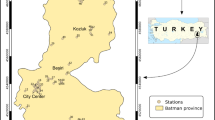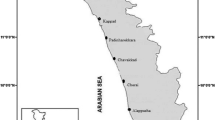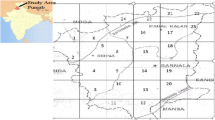Abstract
Since mining activities are known to contribute immensely to human exposure to ionizing radiation of terrestrial origin, the berylium mining site in Ifelodun is believed to cause radiological impacts. Forty-eight samples of surface and ground waters were collected within this area and analyzed in order to assess radon (222Rn) radioactivity level and its associated effective doses. The 222Rn activity concentration in the ground and surface waters were analyzed using a calibrated RAD7-active electronic detector big bottle system. The fact-findings from the mean Radon concentration and the estimated annual effective doses for adults, children, and infants reveals values that were mostly above the recommended limits set by regulatory bodies. The order of radiological risk follow the pattern infant > children > adult. All the estimated values of the cancer risks for both surface and ground water using the Monte Carlo simulation are higher than the recommended value of 0.2 (× 10−3) provided by ICRP and UNSCEAR. Owing to this radiation risk, strict and effective measures need to be put in place to safeguard populace in the area and the workers in the mining site.



Similar content being viewed by others
References
Ajadi BS, Adaramola MA, Adeniyi A, Abubakar MI (2016) Effect of effluents discharge on public health in Ilorin Metropolis, Nigeria. Ethiopian J Environ Stud Manage 9(4):389–404. https://doi.org/10.4314/ejesm.v9i4.1
Ajibola et al (2021) Assessment of annual effective dose associated with radon in drinking water from gold and bismuth mining area of Edu, Kwara, North-central Nigeria. Pollution 7(1):231–240. https://doi.org/10.22059/poll.2020.309470.892
Akinnagbe DM et al (2018) Assessment of radon concentration of ground water in IjeroEkiti. Manila J Sci 11:32–41
Ali A, Ahmed RS (2013) Estimated the mean of annual effective dose of radon gases for drinking water in some locations at Al-Najaf City. J Kufa Phys 5(2): 53–58
Audi G, Wapstra AH, Thibault C, Blachot J, Bersillon O (2003) The NUBASE evaluation of nuclear and decay properties (PDF). Nucl Phys A 729:3–128
Bello S, Nasirub R, Garbab NN, Adeyemo DJ (2020) Annual effective dose associated with radon, gross alpha and gross beta radioactivity in drinking water from gold mining areas of Shanono and Bagwai, Kano state. Nigeria Microchem J 154:104551. https://doi.org/10.1016/j.microc.2019.104551
Culot HV, Olson HG, Sciager K (1976) Effective diffusion coeffient of radon in concrete theory and methods for field measurements. Health Phys 30:263–270
Durridge Radon Instrumentation (2013) Big bottle RAD H2O user manual. DUIRRIDGE Company Inc Billerica, USA
Hurlburt S (1989) Radon - a real killer or just an unsolved mystery? Water Well J 43(6):34–41
IARC (1988) International agency for research on cancer, monograph on the evaluation of carcinogenic risks to humans: man made mineral fibres and radon, vol. 43. IARC Monograph, Lyon, France. https://publications.iarc.fr/Book-And-Report-Series/Iarc-Monographs-On-The-Identification-Of-Carcinogenic-Hazards-To-Humans/Man-Made-Mineral-Fibres-And-Radon-1988 Accessed 26 Jan 2021
Ibiremo OS, Ipinmoroti RR, Ogunlade MO, Daniel MA, Iremiren GO (2010) Assessment of soil fertility for cocoa production in Kwara State: Southern Guinea Savanna Zone of Nigeria. J Agri Sci 1(1):11–18
ICRP (1997) The 1990 Recommendation of the International Commission of Radiological Protection, 21 – 23, Elsevier Health Sciences, USA, 1997
ICRP (2005) International commission on radiation protection. Ann ICRP 60:411–440
ICRP (2010) Lung cancer risk from radon and progeny and statement on radon, (International Commission on Radiological Protection) ICRP Pub. 115–120
Isinkaye MO, Ajiboye Y (2017) Assessment of annual effective dose due to radon concentrations in deep and shallow wells within Ekiti State. Nigeria Radioprotection 52(3):167–170. https://doi.org/10.1051/radiopro/2017014
Kayode JS, Nawawi MNM., Baioumy HM, Khalil AE, Khiruddin BA (2015) Delineation of the subsurface geological structures of Omu-Aran area, south-western Nigeria, using aeromagnetic data. National Physics Conference 2014 (PERFIK 2014) AIP Conf Proc 1657: 040012–1 – 040012–5. https://doi.org/10.1063/1.4915173
Keramati H et al (2018) Radon 222 in drinking water resources of Iran: a systematic review, meta-analysis and probabilistic risk assessment (Monte Carlo simulation). Food Chem Toxicol 115:460–469. https://doi.org/10.1016/j.fct.2018.03.042
Megwara JU, Udensi EE (2014) Structural analysis using aeromagnetic data: case study of parts of Southern Bida Basin, Nigeria and the surrounding basement rocks. Earth Sci Res 3(2). https://doi.org/10.5539/esr.v3n2p27
NAS (1999) National Academy of Science. Report of the Committee on risk assessment of exposure to radon in drinking water, board on radiation effects research, commission on life sciences, National Research Council, National Academy Press, Washington, DC
Nasir T, Shah M (2012) Measurement of annual effective doses of radon from drinking water and dwellings by CR-39 track detectors in Kulachi City of Pakistan. J Basic Appl Sci 8:528–536
Ndontchueng MM, Simo A, Nguelem EJM, Bayala JF, Kryeziu D (2013) Preliminary study of natural radioactivity and radiological risk in Cameroon. Int J Sci Technol 3(12):372–377
Omeje M et al (2021) Measurements of seasonal variations of radioactivity distributions in riverine soil sediment of Ado-Odo Ota, South-West Nigeria: probabilistic approach using Monte Carlo. Radiat Prot Dosimetry 193(2):76–89. https://doi.org/10.1093/rpd/ncab027
Oni OM et al (2014) Radon concentration in groundwater of areas of high background radiation level in Southwestern Nigeria. Niger J Phys 25(1):64–67
Orosun MM (2021) Assessment of arsenic and its associated health risks due to mining activities in parts of North-Central Nigeria: probabilistic approach using Monte Carlo. J Hazard Mater 412:125262. https://doi.org/10.1016/j.jhazmat.2021.125262
Orosun MM et al (2020a) Monte Carlo approach to risks assessment of heavy metals at automobile spare part and recycling market in Ilorin. Niger Sci Rep 10:22084. https://doi.org/10.1038/s41598-020-79141-0
Orosun MM, Alabi AB, Olawepo AO, Orosun RO, Lawal TO, Ige SO (2018) Radiological safety of water from Hadejia River. IOP Conf Ser Earth Environ Sci 173:012036. https://doi.org/10.1088/1755-1315/173/1/012036
Orosun MM, Oniku AS, Adie P, Orosun OR, Salawu NB, Louis H (2020b) Magnetic susceptibility measurement and heavy metal pollution at an automobile station in Ilorin, North-Central Nigeria. Environ Res Commun 2:015001. https://doi.org/10.1088/2515-7620/ab636a
Orosun MM, Oyewumi KJ, Usikalu MR, Onumejor CA (2020c) Dataset on radioactivity measurement of beryllium mining field in Ifelodun and gold mining field in Moro, Kwara State, North-Central Nigeria. Data Br 31:105888. https://doi.org/10.1016/j.dib.2020.105888
Orosun MM, Usikalu MR, Oyewumi KJ, Achuka JA (2020d) Radioactivity levels and transfer factor for granite mining field in Asa, North-Central Nigeria. Heliyon 6(6):e04240. https://doi.org/10.1016/j.heliyon.2020.e04240
Orosun MM, Usikalu MR, Oyewumi KJ, Adagunodo AT (2019) Natural radionuclides and radiological risk assessment of granite mining field in Asa, North-central Nigeria. MethodsX 6:2504–2514. https://doi.org/10.1016/j.mex.2019.10.032
Orosun MM, Usikalu MR, Oyewumi KJ, Oladapo OF (2021a) Radiological hazard assessment of sharp-sand from Ilorin-East, Kwara State. Nigeria J Phys Conference Series 1734(1):012040. https://doi.org/10.1088/1742-6596/1734/1/012040
Orosun MM, Ajibola TB, Akinyose FC, Osanyinlusi O, Afolayan OD, Mahmud MO (2021b) Assessment of ambient gamma radiation dose and annual effective dose associated with radon in drinking water from gold and lead mining area of Moro, North-Central Nigeria. J Radioanal Nucl Chem 328:129–136. https://doi.org/10.1007/s10967-021-07644-9
Orosun MM et al (2017) Natural radionuclide concentration and radiological impact assessment of soil and water from Dadinkowa Dam, Northeast Nigeria. J Niger Assoc Math Phys 42(1):307–316
Oyegun RO (1985) The use and waste of water in a third world city. Geo J 10(2):205–210. https://doi.org/10.1007/bf00150741
Saghi MH, Mohammadi AA, Ghaderpoori M, Ghaderpoury A, Alinejad A (2019) Estimate the effective dose of gamma radiation in Iran cities: lifetime cancer risk by Monte Carlo simulation model. Environ Geochem Health 41:2549–3255. https://doi.org/10.1007/s10653-019-00300-y
Sonzogni A (2008) Interactive chart of nuclides. National Nuclear Data Center: Brookhaven National Laboratory. http://www.nndc.bnl.gov/chart/ Accessed 6 June 2019
UNSCEAR (2000) United Nations Scientific Committee on the effects of atomic radiations. The General Assembly with scientific annex. United Nation, New York. http://www.unscear.org/docs/reports/2000/11 80076. Accessed 6 June 2019
US-EPA (1999) Radon in drinking water: health risk reduction and cost analysis. Federal Register 64, Washington
WHO (2008) Guidelines for drinking-water quality [electronic resource]: incorporating 1st and 2nd addende, 3rd Ed., Recommendations. Geneva. 1:515
WHO (2011) Guidelines for drinking water quality, 4th edition, World Health Organisation, Geneva, Chapter 9: Radiological aspects
Zhang L et al (2017) Probabilistic risk assessment of Chinese residents’ exposure to fluoride in improved drinking water in endemic fluorosis areas. Environ Pollut 222:118–125. https://doi.org/10.1016/j.envpol.2016.12.074
Acknowledgements
The authors wish to acknowledge the supports enjoyed from the entire staffs of IBRAJ NIGERIA LIMITED. We appreciate the suggestions of the anonymous reviewers.
Author information
Authors and Affiliations
Contributions
MMO, TBA, and BRF conceived and designed the research work, collect the data, and wrote the paper. FCA, BNS, LH, KRA, and ADA performed the risks analysis and final compilation of the work.
Corresponding author
Ethics declarations
Conflict of interest
The authors declare no competing interests.
Additional information
Responsible Editor: Amjad Kallel
Highlights
• All the measured samples have radon concentration greater than the maximum permissible limit of 11.1 Bq/l and 10 Bq/l by USEPA and WHO, respectively.
• The radon concentration is higher in the ground water compared to the surface water.
• The estimated mean annual effective dose for all age groups is higher than the recommended limits.
• The order of radiation hazard to all age groups follows the order; infant > children > adult.
Rights and permissions
About this article
Cite this article
Orosun, M.M., Ajibola, T.B., Farayade, B.R. et al. Radiological impact of mining: new insight from cancer risk assessment of radon in water from Ifelodun beryllium mining, North-Central Nigeria using Monte Carlo simulation. Arab J Geosci 14, 2380 (2021). https://doi.org/10.1007/s12517-021-08670-3
Received:
Accepted:
Published:
DOI: https://doi.org/10.1007/s12517-021-08670-3




